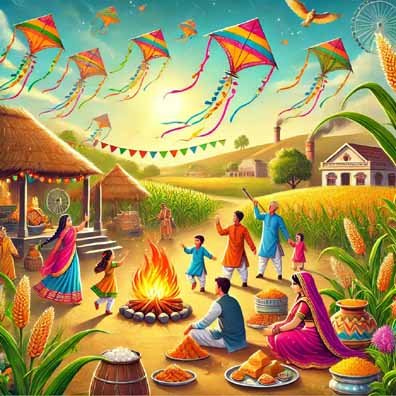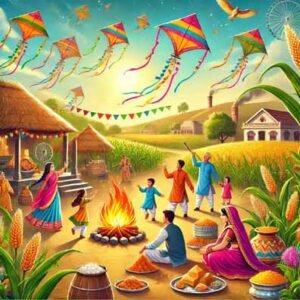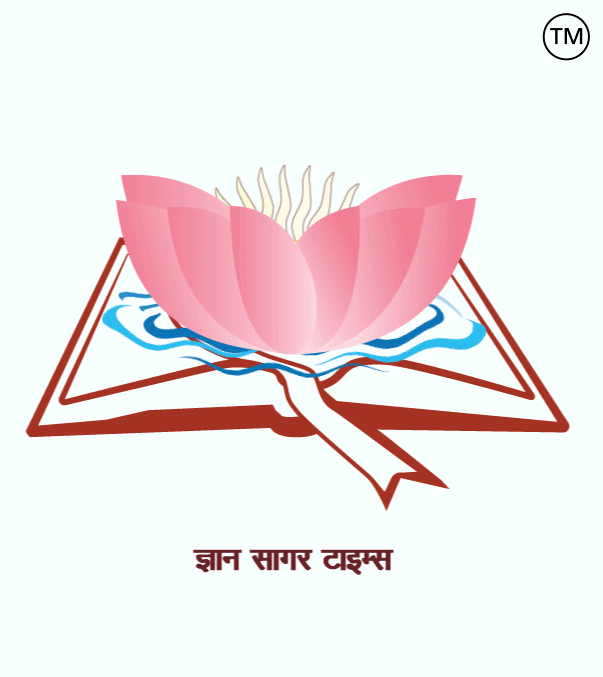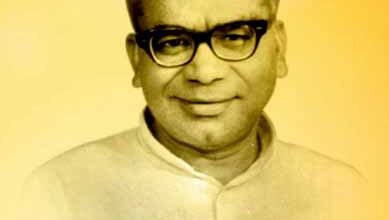
संक्राति…
भारतीय संस्कृति के हर रंग में विविधता है. एक और जहाँ दुनिया के कई देशों में नव वर्ष की शुरुआत हो चुकी है वहीँ सनातन संस्कृति में अभी वर्ष अपने अंतिम पड़ाव की और अग्रसर है. पौष का महीना खत्म हो गया है और माघ के महीने की शुरुआत हो चुकी है साथ ही खगोलीय घटना भी हुई, सूर्य भी उत्तरायण हो गये.
हर वर्ष 14-15 जनवरी को उत्तर भारत में मकर संक्रांति, पंजाब और हरियाणा राज्यों में लोहड़ी और दक्षिण भारत में पोंगल पर्व मनाया जाता है. हर वर्ष 14-15 जनवरी को किसानों का पर्व बड़े ही धूमधाम और हर्षोल्लास के साथ मनाया जा रहा है.
बीते कुछ समय पहले ही जब रूहानी ठंड की शुरुआत के समय सूर्य दक्षिणायन हुए और ठंड की शुरुआत हुई थी वहीं , 14-15 जनवरी को सूर्य उत्तरायण हो गए. अभी संक्रांति काल चल रहा है. संक्रांति की समाप्ति के साथ ही हेमंत ऋतू भी समाप्त हो जाएगी और वसंत का आगमन होगा.
संक्राति का अर्थ होता है सूर्य के एक राशि से दुसरे राशि में प्रवेश करना या यूँ कहें कि, एक राशि से दुसरे राशि में गमन करना. यह ज्योतिषीय गणना अनुसार प्रति वर्ष 14-15 जनवरी को पड़ता है. हम सभी जानते हैं कि, पृथ्वी की परिक्रमा पथ जो अंडाकार है उसे 360 अंशों में 30-30 अंशों के समूह में 12 राशियों में विभाजित किया गया है.
ज्ञात है कि, 365 दिन 06 घंटे का एक साल होता है जबकि, चन्द्र वर्ष 354 दिनों का होता है चुकीं, चन्द्रमा में परिवर्तन होता ही रहता है, इसिलिय चन्द्रवर्ष निश्चित नहीं होता है. इसी परिवर्तन के कारण हर चार सालों में फरवरी 29 दिनों का होता है. सूर्य के उत्तर से दक्षिण की ओर जाने की अवधि को दक्षिणायन तथा दक्षिण से उत्तर की ओर के जाने को उत्तरायण कहते हैं.
समय के साथ मकर संक्रांति के दिन में भी परिवर्तन हो रहा है. कभी यह पर्व 21-22 दिसंबर को मनाया जाता था वहीँ अब 14-15 जनवरी को मनाया जाता है. इसका बड़ा कारण है सूर्य के राशि परिवर्तन के समय में धीरे-धीरे बदलाव का होना. सूर्य के राशि परिवर्तन के समय में धीरे-धीरे बदलाव होने से मकर संक्रांति की तारीख एक दिन आगे बढ़ जाती है. आने वाले कुछ सालों बाद इस पर्व की तारीख एक दिन बढ़कर 15-16 जनवरी हुआ करेगी.
पौराणिक ग्रंथों के अनुसार, संक्रमण पर्व मकर संक्रान्ति में मकर का विशेष महत्व बताया गया है. इसकी अलग तरह से विवेचना की गई है. चुकीं मकर मत्स्य वर्ग में आता है और माँ गंगा का वाहन भी है और गंगा को मकरवाहिनी भी कहते है. वायुपुराण के अनुसार, मकर को नौ निधियां भी कहते हैं. ये नौ निधियां हैं पद्म, महापद्म, शंख, मकर, कच्छप, मुकुन्द, कुन्द नील और खर्व. पृथ्वी की एक अक्षांश रेखा को मकर रेखा कहते हैं जबकि, ज्योतिष गणना के बारह राशियों में से दसवीं राशि का नाम मकर है. श्रीमद्भागवत के अनुसार, सुमेरु पर्वत के उत्तर में दो पर्वत हैं उनमें से एक का नाम मकर पर्वत भी है. पुराणों के अनुसार, कामदेव की पताका का प्रतीक होता है मकर इसीलिए, कामदेव को मकरध्वज भी कहा जाता है.
महाभारत पुराण में इस तथ्य का स्पष्ट उल्लेख है कि, शर–शैय्या पर पड़े गंगापुत्र भीष्म से दर्शन करने आये ऋषियों से सूर्य के उत्तरायण होने पर अपने शरीर-त्याग करने का संकल्प दुहराते हैं वहीँ, शिव पुराण के अनुसार, उत्तरायण एवं मकर संक्रान्ति के अवसर पर हवन-पूजा, खान-पान में तिल एवं तिल से बनी वस्तुओं पर अधिक जोर दिया गया है. सूर्य जब उत्तरी गोलार्द्ध में रहता है तब रवी की फसल चना, गेहूं आदि फसल पकने की स्थिति में होती है. इस समय सूर्य के ताप से उन फसलों को बढ़ने और पकने में सहायता मिलती है.
वैज्ञानिकों के अनुसार, उत्तरायण में सूर्य का ताप शीत के प्रकोप को कम करता है वहीं, पुराणकारों ने भी मकर संक्रान्ति को सूर्य उपासना का विशिष्ट पर्व माना है. इस अवसर पर भगवान सूर्य की उपासना गायत्री मंत्र के साथ पूजा-उपासना, यज्ञ-हवन का अलौकिक महत्व होता है. आयुर्वेद के जानकारों के अनुसार, शीतकालीन ठण्डी हवा शरीर में अनेक रोगों को जन्म देती है. चरक संहिता के अनुसार, इस मौसम में घी-तेल, तिल-गुड़, गन्ना, धूप और गर्म पानी का प्रयोग करना चाहिए.
जहाँ एक और ऋषियों ने सुखी जीवन के लिए अनेकानेक विधाओं का उल्लेख किया है उसमे नदी स्नान का विशेष महत्व दिया गया है. ज्ञात है कि, नदियों के उद्गम स्थान पर्वत होते हैं, जहाँ से ये नदियाँ निकलती हैं और आप जानते ही हैं कि इन पर्वतों पर दिव्य औषधियाँ भी फलती-फूलती हैं उनमे वर्षा के जल में मिलकर नदियों में गिरती हैं और उन नदी के पानी में स्नान का महत्व और भी बढ़ जाता है.
मकर संक्रांति एक ऐसा त्योहार है जो भारत की विविधता और सांस्कृतिक समृद्धि को दर्शाता है. ज्ञानसागरटाइम्स परिवार की ओर से लोहड़ी, पोंगल और मकर संक्रांति की हार्दिक शुभकामनाएँ.
========== ========= ===========
Sankranti…

Indian culture has diversity in every colour. While the New Year has begun in many countries of the world, in Sanatan culture the year is still moving towards its final stage. The month of Paush has ended and the month of Magh has begun and along with that an astronomical event also took place, the Sun also moved northwards.
Every year on 14-15 January Makar Sankranti is celebrated in North India, Lohri in Punjab and Haryana states and Pongal festival in South India. Every year on 14-15 January the festival of farmers is celebrated with great pomp and gaiety.
Just some time back when the Sun moved southwards at the time of the beginning of spiritual cold and cold had begun, on 14-15 January the Sun moved northwards. Right now the Sankranti period is going on. With the end of Sankranti, the winter season will also end and spring will arrive.
Sankranti means the entry of the Sun from one zodiac sign to another or in other words, the movements from one zodiac sign to another. According to astrological calculations, it falls on 14-15 January every year. We all know that the orbit of the Earth, which is oval, has been divided into 12 zodiac signs in groups of 30 degrees each in 360 degrees.
It is known that a year consists of 365 days and 06 hours, whereas the lunar year consists of 354 days. Since the moon keeps changing, the lunar year is not fixed. Due to this change, February is 29 days every four years. The period of the Sun moving from north to south is called Dakshinayan and the movement from south to north is called Uttarayan.
With time, the day of Makar Sankranti is also changing. This festival was once celebrated on 21-22 December, whereas now it is celebrated on 14-15 January. The main reason for this is the gradual change in the time of the change of the Sun’s zodiac sign. Due to the gradual change in the time of change of the Sun’s zodiac sign, the date of Makar Sankranti moves forward by one day. After a few years, the date of this festival will move forward by one day to 15-16 January.
According to mythological texts, the special importance of Makar has been told in the transition festival Makar Sankranti. It has been interpreted differently. Since Makar comes in the Matsya category and is also the vehicle of Mother Ganga Ganga is also called Makarvaahini. According to Vayu Purana, Makar is also called nine treasures. These nine treasures are Padma, Mahapadma, Shankh, Makar, Kachhapa, Mukunda, Kund Neel and Kharva. A latitude line of the earth is called Makar Rekha, whereas, out of the twelve zodiac signs of astrology calculation, the name of the tenth zodiac sign is Capricorn. According to Shrimad Bhagwat, there are two mountains to the north of Sumeru Mountain; one of them is also called Makar Parvat. According to the Puranas, Makara is the symbol of Kamadeva’s flag, therefore, Kamadeva is also called Makardhwaj.
It is mentioned in the Mahabharata Purana that the sages who came to see Gangaputra Bhishma lying on the bed of arrows, repeat the resolution of sacrificing their bodies when the Sun moves northwards. Whereas, according to the Shiva Purana, on the occasion of Uttarayan and Makar Sankranti, more emphasis has been given to sesame and sesame products in havan-puja, food and drink. When the Sun is in the northern hemisphere, the Rabi crops like gram, wheat etc. are in the ripening stage. At this time, the heat of the Sun helps those crops to grow and ripen.
According to scientists, the heat of the Sun in Uttarayan reduces the severity of winter, whereas the writers of the Puranas have also considered Makar Sankranti as a special festival of Surya worship. On this occasion, worship of Lord Surya, worship with Gayatri Mantra, and Yagna-Havan has supernatural importance. According to Ayurveda experts, cold winter air gives rise to many diseases in the body. According to Charak Samhita, ghee oil, sesame jaggery, sugarcane, sunlight and hot water should be used in this season.
Where the sages have mentioned many methods for a happy life, special importance has been given to river bathing. It is known that the origin of rivers are mountains, from where these rivers emerge and you know that divine medicines also flourish on these mountains, they mix with rainwater and fall into the rivers and the importance of bathing in those river water increases even more.
Makar Sankranti is a festival that reflects the diversity and cultural richness of India. Hearty greetings of Lohri, Pongal and Makar Sankranti from the Gyan Sagar Times family.





